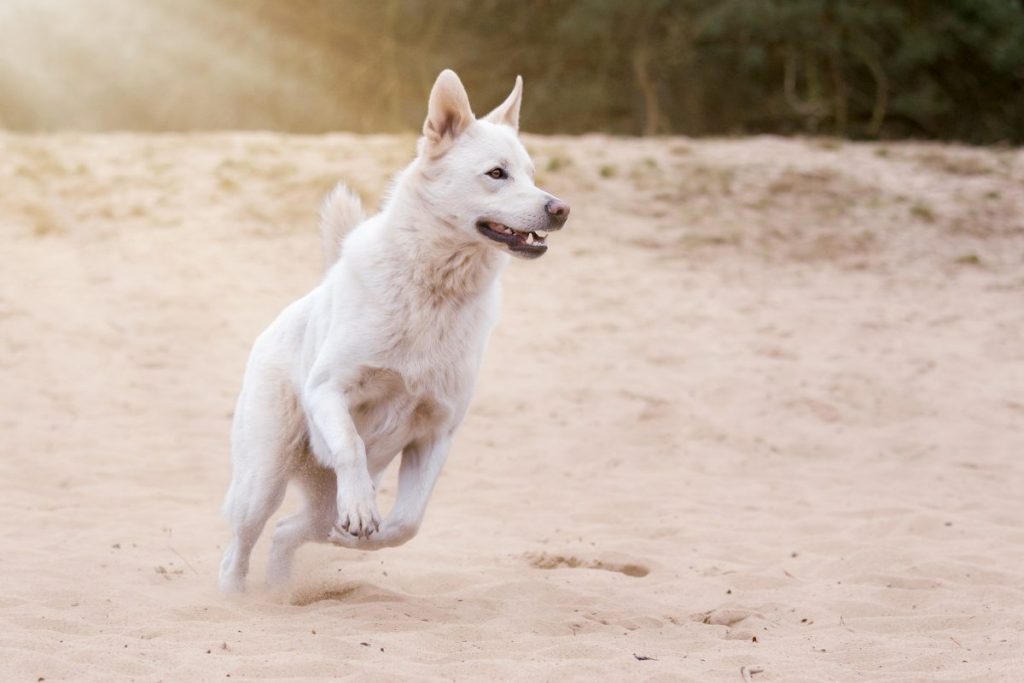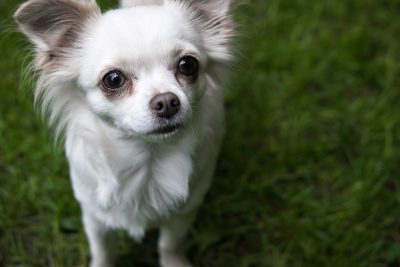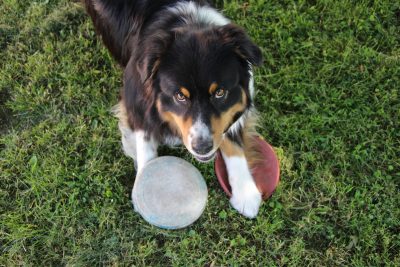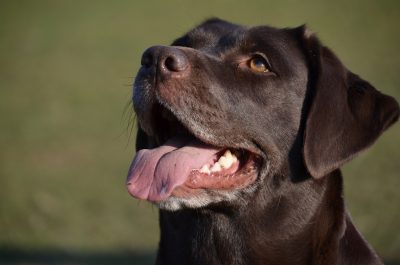Everyone has experienced a hyper dog that is overly excited and greets everyone with lots of licks and jumps. If the response to this enthusiasm is one of affection – like sympathetic petting, the over-the-top greetings will continue. Dogs seek human attention. Rewarding your dog with it will only re-enforce his hyperactive behavior.
If your dog is hyperactive, it is important to only respond to calmness. When your dog is in a frenetic state, do not speak to, touch, or make eye contact with him. If he jumps up on you, turn your back on him and push him down. It is essential to remember not to engage when your dog is behaving in that manner.
If you ignore this bad behavior, your dog will soon learn to approach you in a quiet, submissive manner. Only then should you give him your attention. Just remember – it’s very easy to inadvertently reward hyperactive energy by displaying it yourself.
Energy Overdose vs. Happiness
Despite appearances, dogs who get overexcited easily often are not happy dogs. Your furry friend is much happier when he is relaxed and feels he doesn’t have to worry about every little thing. This is another reason for you to create a calm and nurturing atmosphere – both in your home and on walks.
Always be mindful of encouraging a state of calmness with your dog. By remaining calm, he will soon realize that he will only get your attention when he behaves. Over-excitement can escalate and lead to situations that get out of hand very quickly – including canine aggression.
Keep Your Dog Active
Dogs are pack animals. In the wild, they travel together to hunt for food, water, and shelter. By taking your pup for a long walk twice a day, you’ll help to fulfill this purpose-driven instinct. Your dog will return home feeling accomplished and exhausted. Merely letting your dog out in the backyard or taking him for quick bathroom walk won’t cut it.
Giving your dog a job will give him something to focus on. It’s essential for high-energy dogs. Is there a beach, mountain or park near you? How about a walking or hiking trail? Even a few trips around the block, taking different routes, will stimulate his mind and exercise his body.
Brain Energy is Better Than Physical Energy
Establish a calm, relaxed atmosphere for your dog. If your dog is in a constant state of hyperactivity, an out-of-control energy burst is just waiting to happen. Dogs brains are wired to work off excess energy both physically and mentally. Some dog breeds require more mental stimulation than others.
Despite being used to race around a track, a Greyhound could spend the rest of his life lounging happily on a couch or bed, while Border Collies would be bored and become anxious with such confinement. All dogs benefit from exercise and mental challenges. Knowing your dog will help you determine the best way to expend his excess energy.
Game Time
Dogs love to play games, and it is important to spend time with your dog playing these games. Anything involving finding treats, catching a ball or Frisbee, or creating an obstacle course goes a long way toward having your dog use his pent-up energy in positive ways. But, during play if your dog becomes too excited or aggressive – stop immediately. Once he settles down, reward him with a treat.
Brain Games
Mental exercise can be just as good for dogs as physical exercise. Challenge your dog to find treats in toys, hide treats or toys around the house, or make him work to pull a treat on a string. This will direct his energy to brainwork and keep him stimulated.
Dogs work for the love of work. Without a job, dogs resort to endless barking, jumping, digging and other undesirable high-energy behaviors. Your dog’s favorite thing to do is play with you!
Understand Your Dog
Hyperactive dogs are very smart and drive-oriented. Understanding your dog’s state of mind will help you adjust your expectations accordingly. Always remember to set your pup up for success in his challenges. Dogs can become frustrated and depressed just like we can. Make sure to offer encouraging praise and rewards along the way! After strenuous exercise, always give your dog a cool-down period. Your dog must have quiet time to allow his energy to dissipate.
Monitor Your Behavior
Ask yourself if you are inadvertently encouraging hyperactivity in your dog by emitting that same level of energy yourself. People are often unaware of their own behavior. Never yell at or hit your dog. Yelling is barking to your pup, and this type of behavior from you will encourage your dog to bark louder and more often. This type of correction only inspires higher levels of excitement and can lead to aggression or hyperactive behavior.
Stay Consistent
Establish a routine of morning and evening walks, playtime, and quiet time with your dog – and stick to it. This will help remove insecurity. Consistency will keep your dog calm and give him reasonable expectations.
And remember – every member of your household must do the same. Be consistent in the way you train him and in what you expect of him. If you aren’t, he will be confused. Always keep training positive and upbeat.
Clicker Training
It is well worth the time and effort you invest in training your dog – and high-drive dogs catch on to clicker training quickly. You can take classes on clicker training to learn how to do it properly and effectively. But like any other training, it’s about repetition. When you see your dog doing something good – click, then reward him with a treat and praise. He’ll soon realize what you expect of him. If he begins to bark, click and wait until he stops to reward him.
Teach your dog to focus on YOU. You can practice while walking to turn the distractions of other dogs back to you. Teach your dog to look at you and sit for a treat. He will learn to look to you for guidance on how he should behave. This will help desensitize him to distractions and turn you into the focus of attention. Clicker training can help you ward off bad behaviors before they develop.
Use Distractions
If your dog is barking at something he sees out of the window and doesn’t respond to your “quiet” command, pull the curtains shut and get him interested in something else. Try to determine what is taking his attention, and remove it, then re-introduce it gradually as he learns more impulse control. Reward the “quiet” command.
Another idea is to keep a mat or small rug near the door, so you can direct your dog to it when company comes. Give him plenty of distractions and rewards to refocus his mind, then progress to the “down, stay” command, lengthening the time required between command and reward.
Teach Commands
In the early stages of training, have your dog sit, then show him a treat. As he reaches for, it say “OFF” and pull it back a bit. Have him wait for it patiently – only a few seconds at first – then give it to him and say “OKAY!” enthusiastically. This teaches him to wait for your command to do something. Try the same thing with a few other challenges.
Soon your dog will learn that “OFF!” means “STOP.” This will work whether he’s jumping on guests or stealing dinner off of the table. All training and learning should progress slowly and with ample rewards. Every dog progresses at different speeds. You will eventually learn how your dog responds to training. Just remain patient with him – and make sure you have treats for him at the end of each session.
Obstacle Courses
You don’t need to be a professional trainer to create an obstacle course for your dog in your backyard. Grab some orange cones and PVC pipes and set them up as slalom poles. Your dog will love leaning how to weave in and out of them. Make sure to leave space for jumping course as well.
Again, it doesn’t have to be fancy. Simple poles or 2 x 4’s and cinder blocks will do. You can also use an old tire swing as a jump-though challenge for your dog if he’s on the more athletic side. With a little training, almost any dog can learn to master these obstacles. Just make sure to make it fun and rewarding. Try mixing up the course to make it more challenging.
If you don’t feel up to the task of calming your hyperactive dog, hiring a trainer is always a good idea. Ask your vet or pet store to recommend a good one. Always remember to never leave your dog outside unsupervised for a long period of time. He will get bored and lonely and eventually get into trouble.
Make sure to walk your dog at least twice a day. Swimming and hiking are wonderful activities as well. Before you leave for work, give your dog a toy where he will have to work to get a treat.
Don’t give up on your dog. Training your dog is easier than you think – and incredibly rewarding. You might even learn to develop a healthier lifestyle for yourself! You will thank yourself – and your furry best friend – for years to come.







